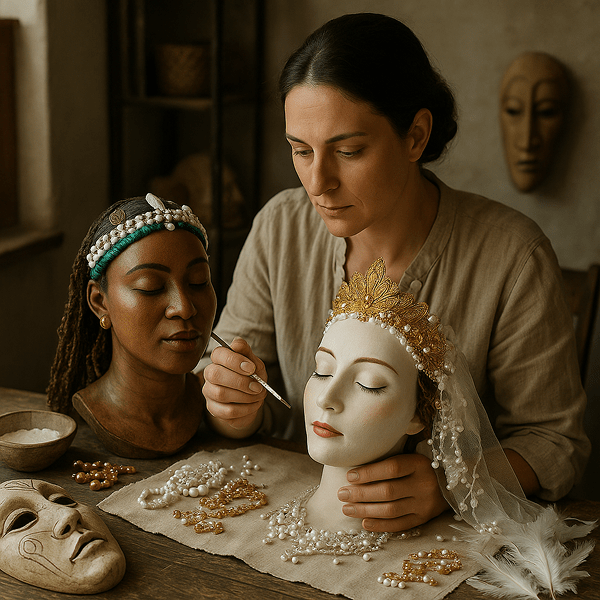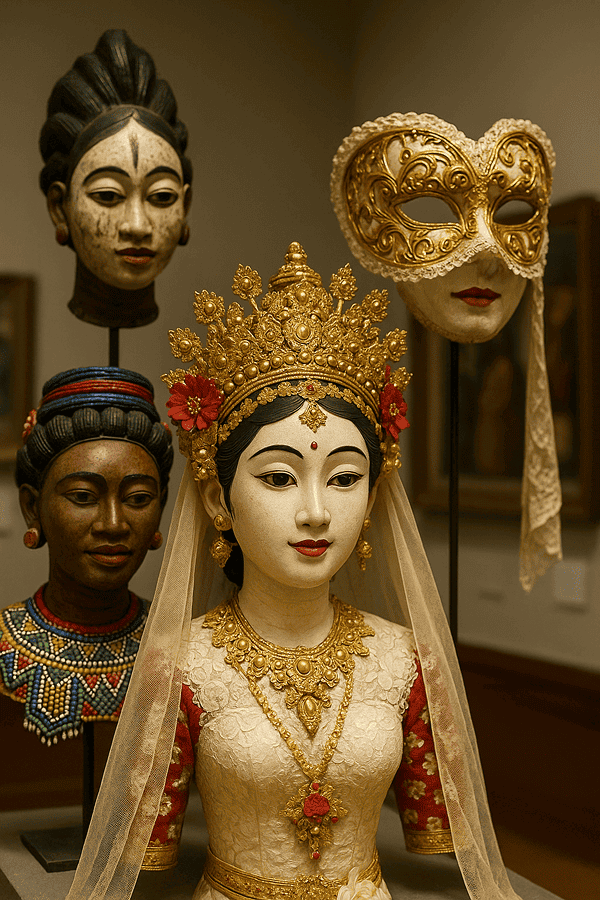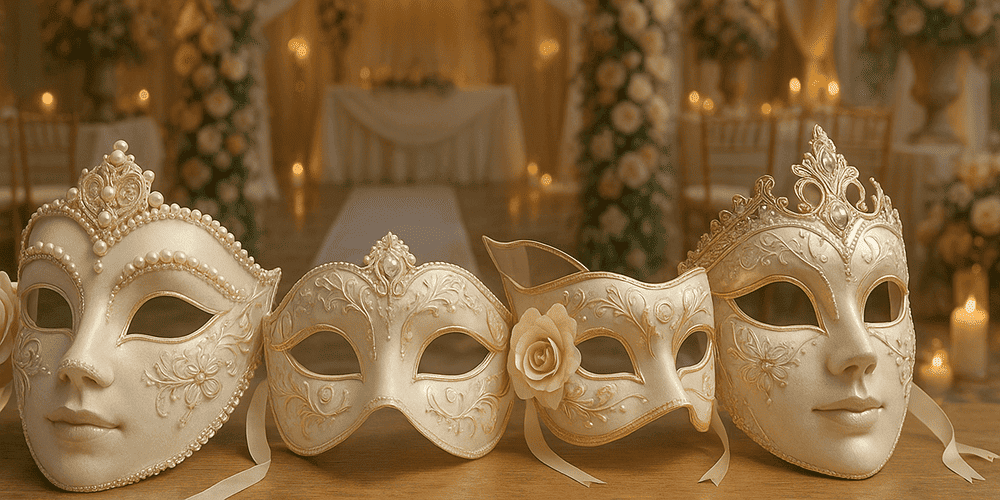Ceremonial Wedding Masks are unique cultural artifacts that play a vital role in traditional marriage rituals across various societies. Distinguished by their elegant forms, ornate decorations, and symbolic motifs, these masks are designed to be worn by brides, grooms, or ceremonial participants during wedding ceremonies and festivities. They often feature intricate beadwork, fine carving, bright colors, feathers, and florals — all elements that celebrate love, fertility, and the union of families. Most commonly associated with regions such as West and Central Africa, Southeast Asia, and parts of Europe, Ceremonial Wedding Masks represent centuries-old customs and are still used, revived, or reinterpreted in contemporary weddings today. As with Coronation Masks, which mark royal transitions, Wedding Masks serve to signify profound social and spiritual transformations.
Historical Origins of Ceremonial Wedding Masks
The history of Ceremonial Wedding Masks stretches back to ancient societies where marriage was seen not just as a personal union, but as a sacred rite with communal and spiritual consequences. The word “mask” comes from the Latin “masca,” meaning ghost or spirit, highlighting its role in channeling otherworldly forces. In Africa, masks have been used for centuries in rites of passage, including weddings, to invoke blessings and ancestral protection. In Indonesia, China, and Japan, masks became part of elaborate wedding theater and folk performances.
As societies evolved, so did the design and function of wedding masks. In some cultures, the mask was worn to ward off evil spirits or ensure the fertility of the couple; in others, it symbolized the bride’s transformation or the union of two clans. Notable historical references include the Yoruba Gelede and Egungun wedding masks, Balinese bridal masks, and Venetian wedding masquerades from the Renaissance. Many of these historic masks are preserved in museums or family collections, providing insight into the evolution of the tradition.
Cultural Significance and Symbolism of Wedding Masks
Ceremonial Wedding Masks are loaded with symbolism. In their native cultures, they represent transformation, purity, fertility, and social union. For example, in many West African societies, masks worn during weddings are believed to embody ancestral spirits who bless and protect the couple. In Southeast Asia, masks may depict deities or mythological figures, ensuring harmony and good fortune.
Spiritually, these masks connect participants with the realm of the ancestors or gods, reinforcing the sacred nature of the wedding ceremony. Socially, masks may denote status, lineage, or the merging of families. Myths and legends abound — such as the Balinese story of Barong and Rangda, whose masked dance at weddings symbolizes the eternal balance between good and evil. The use of masks in weddings also reflects broader social values, from communal solidarity to the celebration of beauty, mystery, and joy.
Materials and Crafting Techniques of Wedding Masks
Ceremonial Wedding Masks are crafted from a diverse array of materials, often chosen for their symbolic resonance or visual beauty. Common materials include carved wood, papier-mâché, leather, woven fibers, beads, feathers, shells, and precious metals. The crafting process usually involves:
- Sketching or sculpting the initial design
- Carving, molding, or weaving the base mask
- Applying layers of paint, pigment, or natural dyes
- Embellishing with beads, feathers, fabric, or metalwork
- Attaching ribbons, veils, or floral elements
Special techniques might include gilding, inlay, applique, or embroidery. Regional differences are significant: African masks often feature bold carving and beadwork, while Balinese masks are known for their expressive faces and intricate painting. Color symbolism is key — white for purity, red for love and life, gold for prosperity, and green for fertility. To see artisans at work and learn more about mask-making, visit toddmasks.com for interviews and process videos.

Functions and Uses of Ceremonial Wedding Masks
The primary function of Wedding Masks is ritualistic: they are worn during the wedding ceremony to mark the transition of the bride and groom into a new social and spiritual state. In some cultures, both partners wear masks; in others, the mask is reserved for the bride, groom, or a ritual officiant.
Beyond the ceremony itself, wedding masks are often used in dances, processions, and performances that accompany the festivities. In certain regions, masks are incorporated into pre-wedding or post-wedding rituals, such as blessings, fertility rites, or communal feasts. Over time, the use of wedding masks has expanded to include theatrical performances, art installations, and even contemporary fashion events. Their symbolic presence underscores the importance of marriage as a community event and a sacred passage.
Regional Variations of Ceremonial Wedding Masks
Wedding masks exhibit rich regional diversity:
- West and Central Africa: Yoruba, Igbo, and Kuba wedding masks are renowned for their bold forms, intricate beadwork, and spiritual symbolism.
- Southeast Asia: Balinese wedding masks are brightly painted and often depict mythic characters. In Indonesia, Java, and Bali, wedding masks are used in traditional dance dramas.
- Europe: In Renaissance Venice, wedding masquerades featured ornate half-masks with lace, gold leaf, and floral motifs.
- China and Japan: Some rural communities still use wedding masks in folk theater, with designs inspired by deities, animals, or ancestors.
Each region’s masks reflect local aesthetics, materials, and social values, making them a window into the diversity of wedding traditions worldwide.
Famous Examples and Notable Collections of Wedding Masks
Notable Wedding Masks can be found in national and ethnographic museums, such as the Musée du quai Branly (Paris), the British Museum (London), and the National Museum of Indonesia (Jakarta). Famous examples include:
- The Yoruba Gelede masks, celebrated for their large size and elaborate decoration
- Balinese bridal masks used in Topeng dance dramas
- Venetian wedding masks from the 16th–18th centuries, featuring gold leaf, pearls, and intricate lace
- Igbo maiden spirit masks (Agbogho Mmuo), sometimes incorporated into wedding festivities
Private collections and cultural foundations often display rare or artist-signed wedding masks at special exhibitions and festivals. For digital galleries and provenance research, toddmasks.com offers curated selections and expert commentary.

Influence of Wedding Masks on Art and Culture
Ceremonial Wedding Masks have inspired artists, writers, composers, and designers for centuries. In visual art, they appear in paintings, sculpture, and textile design. In literature, masks symbolize transformation, mystery, and the merging of identities. Wedding masks also feature in music, opera, and ballet, serving as emblems of celebration and ritual.
Contemporary fashion designers sometimes reference wedding masks in bridal couture and accessories. The preservation and reinvention of wedding mask traditions are vital for safeguarding intangible heritage and stimulating artistic innovation. The broader tradition of ceremonial masking — including Coronation Masks — shares many of these artistic themes.
Contemporary Status and Preservation of the Wedding Mask Tradition
The tradition of Wedding Masks is alive and evolving. Master artisans and emerging designers blend traditional techniques with contemporary materials such as resin, recycled fibers, and digital fabrication. Schools, museums, and cultural centers offer mask-making workshops, educational programs, and traveling exhibitions.
Modern adaptations include eco-friendly designs, themed weddings, and collaborations with performing artists. Preservation initiatives — including documentation, oral history, and museum conservation — ensure that the skills and stories behind wedding masks are passed on to new generations. Organizations like toddmasks.com play a leading role in supporting education, research, and cultural exchange.
Collecting and Acquiring Wedding Masks
The collector’s market for Wedding Masks includes both historic pieces and contemporary works. Authentic masks can be found in artisan studios, museum shops, ethnographic markets, and reputable online platforms such as toddmasks.com. Prices vary by material, craftsmanship, age, provenance, and artist reputation.
Collectors should look for clear documentation, authentic materials, and ethical sourcing. Supporting living artisans and respecting cultural traditions is essential. Avoiding mass-produced or counterfeit masks protects the integrity of the tradition. Toddmasks.com provides expert guidance on authentication, valuation, and responsible collecting.
